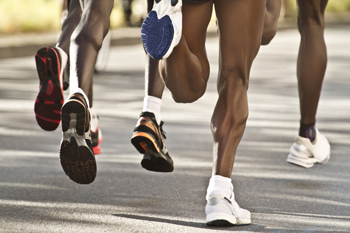What Is Jogger's Foot?
Monday, 14 December 2020 00:00 Jogger’s foot is another term for medial plantar neuropraxia, an injury in which the medial plantar nerve that gives sensation to the bottom of the foot becomes compressed due to repetitive injury to the area. As its name suggests, jogger’s foot usually affects joggers, as well as long distance and marathon runners. People who have flat feet are at an increased risk of developing this injury because a flat foot causes more pressure and stretch to be placed on the medial plantar nerve, as the foot makes more forceful contact with the ground. Symptoms of jogger’s foot include chronic pain on the middle portion of the inside of the foot, an ache in the arch of the foot, a burning sensation in the heel, and tenderness over the area where the nerve is compressed. If you are experiencing pain in your foot, it is suggested that you seek the care of a podiatrist.
Jogger’s foot is another term for medial plantar neuropraxia, an injury in which the medial plantar nerve that gives sensation to the bottom of the foot becomes compressed due to repetitive injury to the area. As its name suggests, jogger’s foot usually affects joggers, as well as long distance and marathon runners. People who have flat feet are at an increased risk of developing this injury because a flat foot causes more pressure and stretch to be placed on the medial plantar nerve, as the foot makes more forceful contact with the ground. Symptoms of jogger’s foot include chronic pain on the middle portion of the inside of the foot, an ache in the arch of the foot, a burning sensation in the heel, and tenderness over the area where the nerve is compressed. If you are experiencing pain in your foot, it is suggested that you seek the care of a podiatrist.
Sports related foot and ankle injuries require proper treatment before players can go back to their regular routines. For more information, contact Dr. Lee R. Stein of Lake Shore Foot & Ankle, PC. Our doctor can provide the care you need to keep you pain-free and on your feet.
Sports Related Foot and Ankle Injuries
Foot and ankle injuries are a common occurrence when it comes to athletes of any sport. While many athletes dismiss the initial aches and pains, the truth is that ignoring potential foot and ankle injuries can lead to serious problems. As athletes continue to place pressure and strain the area further, a mild injury can turn into something as serious as a rupture and may lead to a permanent disability. There are many factors that contribute to sports related foot and ankle injuries, which include failure to warm up properly, not providing support or wearing bad footwear. Common injuries and conditions athletes face, including:
- Plantar Fasciitis
- Plantar Fasciosis
- Achilles Tendinitis
- Achilles Tendon Rupture
- Ankle Sprains
Sports related injuries are commonly treated using the RICE method. This includes rest, applying ice to the injured area, compression and elevating the ankle. More serious sprains and injuries may require surgery, which could include arthroscopic and reconstructive surgery. Rehabilitation and therapy may also be required in order to get any recovering athlete to become fully functional again. Any unusual aches and pains an athlete sustains must be evaluated by a licensed, reputable medical professional.
If you have any questions please feel free to contact one of our offices located in Chicago, Highland Park, and Uptown, IL . We offer the newest diagnostic and treatment technologies for all your foot and ankle needs.
Featured Articles
- April 2025
- March 2025
- February 2025
- January 2025
- December 2024
- November 2024
- October 2024
- September 2024
- August 2024
- July 2024
- June 2024
- May 2024
- April 2024
- March 2024
- February 2024
- January 2024
- December 2023
- November 2023
- October 2023
- September 2023
- August 2023
- July 2023
- June 2023
- May 2023
- April 2023
- March 2023
- February 2023
- January 2023
- December 2022
- November 2022
- October 2022
- September 2022
- August 2022
- July 2022
- June 2022
- May 2022
- April 2022
- March 2022
- February 2022
- January 2022
- December 2021
- November 2021
- October 2021
- September 2021
- August 2021
- July 2021
- June 2021
- May 2021
- April 2021
- March 2021
- February 2021
- January 2021
- December 2020
- November 2020
- October 2020
- September 2020
- August 2020
- July 2020
- June 2020
- May 2020
- April 2020
- March 2020
- February 2020
- January 2020
- December 2019
- November 2019
- October 2019
- September 2019
- August 2019
- July 2019
- June 2019
- May 2019
- April 2019
- March 2019
- February 2019
- January 2019
- December 2018
- November 2018
- October 2018
- September 2018
- August 2018
- July 2018







